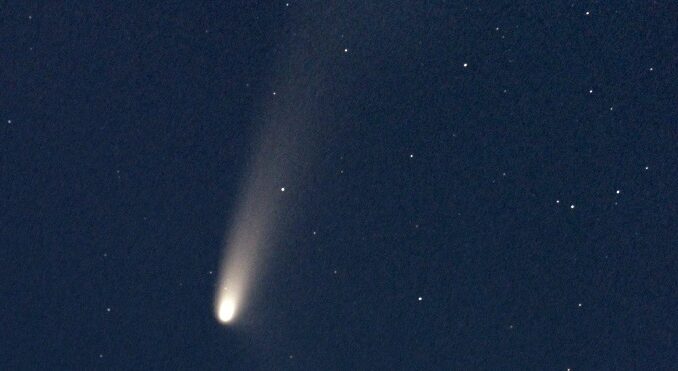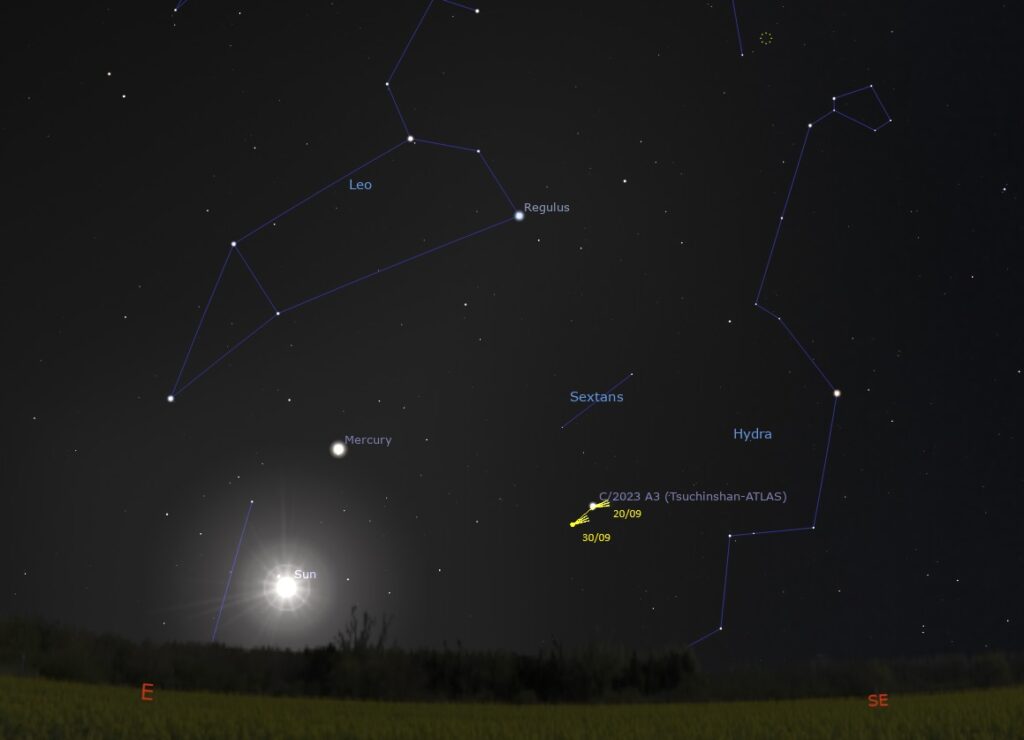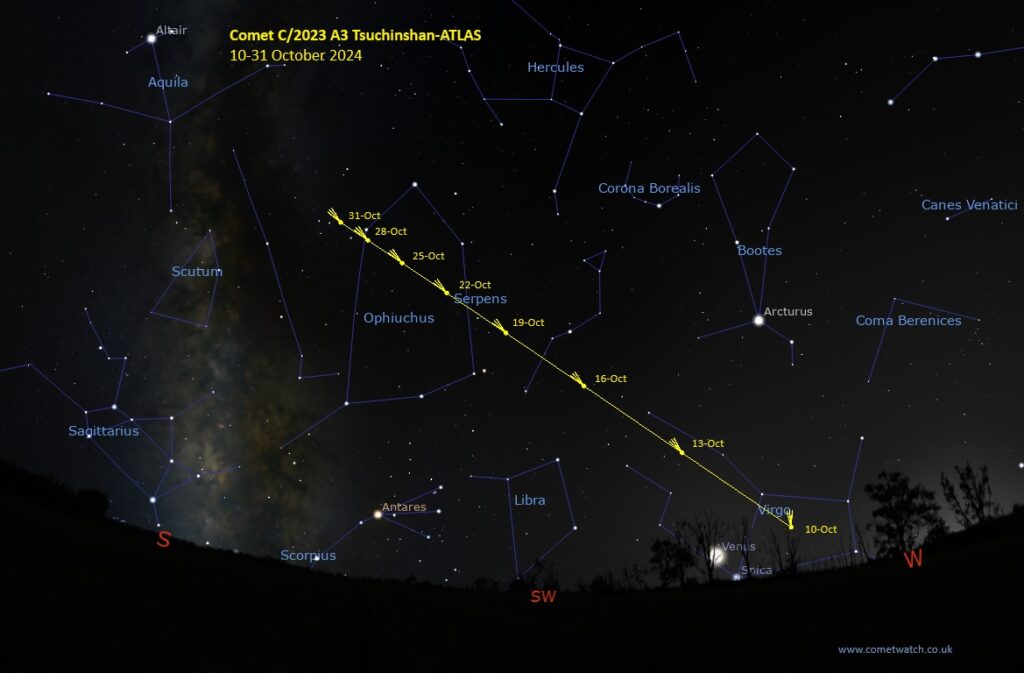
Comets are some of the most fascinating and elusive objects in the night sky, and this autumn, stargazers have a special treat: Comet Tsuchinshan-ATLAS. This newly discovered comet is expected to grace our skies, offering a rare opportunity to observe it as it journeys through the solar system. Here’s everything you need to know about this cosmic traveller, its discovery, and how you can observe it this season.
The Discovery of Comet Tsuchinshan-ATLAS
Comet Tsuchinshan-ATLAS, officially designated C/2023 A3 (Tsuchinshan-ATLAS), was first discovered in early January 2023 through two different surveys. The comet was initially spotted by the Tsuchinshan Observatory in China and later independently detected by the Asteroid Terrestrial-impact Last Alert System (ATLAS), a network of telescopes designed to monitor asteroids and other near-Earth objects. Its orbit suggests that it is on a long-period trajectory, taking thousands of years to complete one orbit around the Sun.
As the comet approaches the inner solar system, excitement is building among astronomers and amateur observers alike. While comets can be unpredictable, early estimates suggest that Comet Tsuchinshan-ATLAS could brighten significantly as it nears the Sun.
Comet Tshuchinshan-ATLAS brightness
Current estimates (September 21st) suggest the comet has a visual brightness of around magnitude +4 and brightening rapidly as expected. This means that Tsuchinshan-ATLAS is already visible to the naked eye!
Observing Opportunities: Late September to October 2024
Starting in late September and continuing into October 2024, Northern Hemisphere observers will have a prime opportunity to spot this comet. Initially visible in the morning sky, the comet will gradually shift to the evening sky in October as it approaches perihelion (its closest point to the Sun). Observers should be mindful of the effects of twilight, as the best views will be when the sky is darkest, either before dawn or after sunset.
Key Dates to Mark on Your Calendar:
- Late September: The comet will first become visible in the morning sky before dawn, positioned low on the eastern horizon.
- October 1-15: The comet will shift into the evening sky as it moves higher in the western sky after sunset. This is expected to be the best time for casual stargazers to observe it.
- Mid to Late October: By this time, the comet will be in the evening sky, passing through the constellation Libra and potentially at its brightest. Be sure to plan observations after the end of astronomical twilight, when the sky is fully dark.
How to Find Comet Tsuchinshan-ATLAS
For those new to stargazing, spotting a comet can be challenging without the right tools. A star finder chart is an essential guide to help you locate the comet in the sky. Below are star charts for Northern Hemisphere observers that show the path of Comet Tsuchinshan-ATLAS as it moves across the constellations.
Finder Chart 1: Late September 2024 – Morning Sky
In late September, Comet Tsuchinshan-ATLAS will be visible in the pre-dawn sky, low on the eastern horizon. Observers should begin looking for the comet about an hour or two before sunrise, as it will be quite faint and close to the horizon. Be mindful of twilight, which starts brightening the sky approximately 90 minutes before sunrise. Located between the constellations of Sextans and Hydra, look for the comet below the feet of the constellation Leo. Binoculars will help greatly, as the comet will still be fairly faint at this stage.

Finder Chart 2: October 2024 – Evening Sky
Through early October, the comet will be too close to the Sun for decent, safe observation. By 10th October the comet will have transitioned to the evening sky, becoming visible shortly after sunset. Look for it low on the western horizon, near the constellation Virgo. Keep in mind that twilight will still affect visibility, so the best time to observe the comet will be about 30 to 45 minutes after sunset, once the Sun has fully set and the sky has darkened. The comet will be gaining brightness, so it should be easier to spot with binoculars or a small telescope.
In mid to late October, Comet Tsuchinshan-ATLAS will reach its brightest and highest point in the evening sky, moving from Virgo into Libra. As it rises higher in the sky, it will be visible for a longer period after sunset, giving observers more time to enjoy the view. During this time, the comet may even be visible to the naked eye under dark skies. Plan your observations for at least an hour after sunset, when astronomical twilight has ended, to get the best view of the comet against a fully dark sky.

Best Observing Tips
- Dark Skies: Get away from city lights to maximize your chances of seeing the comet. Rural locations offer the best conditions.
- Use Binoculars or a Small Telescope: While the comet may become visible to the naked eye, using optical aids will enhance your viewing experience, especially when it is still faint in the early stages.
- Be Mindful of Twilight: Observing right before dawn or just after dusk can be tricky because of twilight. Plan your sessions when the sky is darkest, either before nautical twilight (pre-dawn) or after astronomical twilight (post-sunset).
- Download a Star Chart App: Apps like SkySafari or Stellarium can help you track the comet in real time.
Final Thoughts
Comet Tsuchinshan-ATLAS is a celestial spectacle you won’t want to miss. Though comets can be unpredictable, the viewing conditions this fall look promising. Whether you’re an experienced astronomer or a beginner, take the time to look up and witness this cosmic event as it travels through the night sky.
Stay tuned for updated star charts and observing guides as the comet’s brightness and position become clearer in the coming weeks!
